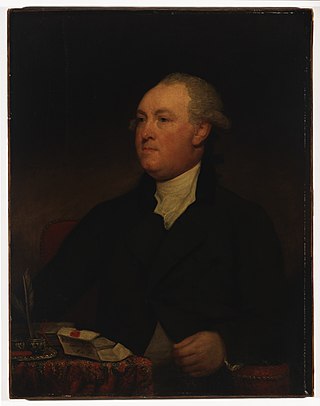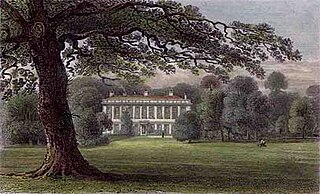
Earl Sydney, of Scadbury in the County of Kent, was a title in the Peerage of the United Kingdom. It was created in 1874 for John Townshend, 3rd Viscount Sydney.

Earl Sydney, of Scadbury in the County of Kent, was a title in the Peerage of the United Kingdom. It was created in 1874 for John Townshend, 3rd Viscount Sydney.
The titles of Baron Sydney (third creation; 1783) and Viscount Sydney (second creation; 1789), were created in the Peerage of Great Britain, for the politician Thomas Townshend (1733–1800), known as Lord Sydney.
Townshend was then succeeded by his son, John Thomas Townshend, 2nd Viscount Sydney (1764–1831).
On his death, the titles passed to his son, the Liberal politician John Robert Townshend, 3rd Viscount Sydney (1805–1890), [1] who was then elevated to the title of earl in 1874. Earl Sydney notably served as Lord Chamberlain of the Household and as Lord Steward of the Household. On his death in 1890, however, in the absence of an heir, all his titles became extinct.

Charles Townshend, 2nd Viscount Townshend, was an English Whig statesman. He served for a decade as Secretary of State for the Northern Department from 1714 to 1717 and again from 1721 to 1730. He directed British foreign policy in close collaboration with his brother-in-law, prime minister Robert Walpole. He was often known as Turnip Townshend because of his strong interest in farming turnips and his role in the British Agricultural Revolution.

Thomas Townshend, 1st Viscount Sydney was a British politician who sat in the House of Commons from 1754 to 1783 when he was raised to the peerage as Baron Sydney. He held several important Cabinet posts in the second half of the 18th century. The cities of Sydney in Nova Scotia, Canada, and Sydney in New South Wales, Australia were named in his honour, in 1785 and 1788, respectively.
Viscount Sydney is a title that has been created twice. The title was elevated twice from a barony, and once into an earldom.
The Peerage of the United Kingdom is one of the five Peerages in the United Kingdom. It comprises most peerages created in the United Kingdom of Great Britain and Ireland after the Acts of Union in 1801, when it replaced the Peerage of Great Britain. New peers continued to be created in the Peerage of Ireland until 1898.

Earl of Leicester is a title that has been created seven times. The first title was granted during the 12th century in the Peerage of England. The current title is in the Peerage of the United Kingdom and was created in 1837.

Earl of Carlisle is a title that has been created three times in the Peerage of England.

Marquess Townshend is a title in the Peerage of Great Britain held by the Townshend family of Raynham Hall in Norfolk. The title was created in 1787 for George Townshend, 4th Viscount Townshend.

Marquess of Bath is a title in the Peerage of Great Britain. It was created in 1789 for Thomas Thynne, 3rd Viscount Weymouth. The Marquess holds the subsidiary titles Baron Thynne, of Warminster in the County of Wiltshire, and Viscount Weymouth, both created in 1682 in the Peerage of England. He is also a baronet in the Baronetage of England.

Marquess of Exeter is a title that has been created twice, once in the peerage of England and once in the peerage of the United Kingdom. The first creation came in the peerage of England in 1525 for Henry Courtenay, 2nd Earl of Devon. For more information on this creation, which was forfeited in 1538, see Earl of Devon.

Earl of the Island of Jersey, usually shortened to Earl of Jersey, is a title in the Peerage of England. It is held by a branch of the Villiers family, which since 1819 has been the Child Villiers family.

Earl of Romney is a title that has been created twice.

Earl of Strafford is a title that has been created three times in English and British history.

Earl or Lord of Clanricarde is a title that has been created twice in the Peerage of Ireland, first in 1543 and again in 1800. The former creation became extinct in 1916 while the 1800 creation is extant and held by the Marquess of Sligo since 1916.

Baron Sydney was a title that was created three times in British history. The title was later elevated twice into a viscounty, and from there, once more into an earldom.
Nathaniel Clements, 2nd Earl of Leitrim, KP PC (Ire), styled The Honourable from 1783 to 1795, and then Viscount Clements to 1804, was an Irish nobleman and politician.

John Robert Townshend, 1st Earl Sydney, known as The Viscount Sydney between 1831 and 1874, was a British Liberal politician. In a ministerial career spanning over 30 years, he was twice Lord Chamberlain of the Household and twice Lord Steward of the Household.
The title Baron Ferrers of Chartley was created on 6 February 1299 for John de Ferrers, son of Robert de Ferrers, 6th Earl of Derby. The daughter of the 6th Baron Ferrers of Chartley, Anne, married Walter Devereux who was summoned to parliament as Lord Ferrers in her right. Their descendants became Earls of Essex and the peerage was forfeited in 1601 on the attainder of Robert Devereux, 2nd Earl of Essex, but restored to his son Robert in 1604, on whose death in 1646 the peerage fell into abeyance. The abeyance was terminated in 1677 when Robert Shirley, a grandson of one of the sisters of the 3rd Earl of Essex, was summoned as Lord Ferrers of Chartley with precedence to the original creation. In 1711, Shirley was created the 1st Earl Ferrers, but the Earldom and Barony separated at his death, the barony going to Elizabeth Shirley, the daughter of his eldest son, while the earldom went to his second son. On the 1741 death of Elizabeth Shirley, 15th Baroness Ferrers of Chartley and wife of the Earl of Northampton, the peerage again briefly fell into an abeyance that was resolved in 1749 by the death of two of the three heiresses, leaving the surviving daughter, Charlotte Compton, wife of the Marquess Townshend, as 16th Baroness Ferrers of Chartley. The barony continued, merged with the marquessate, until the death of George Ferrars Townshend, 3rd Marquess Townshend in 1855, when it again fell into abeyance between his two sisters and their heirs. It remains in abeyance.
John Thomas Townshend, 2nd Viscount Sydney of St Leonards was a British peer and Member of Parliament.
Sidney or Sydney is an English surname. It is probably derived from an Anglo-Saxon locational name, [æt þǣre] sīdan īege, "[at the] wide island/watermeadow" . There is also a folk etymological derivation from the French place name Saint Denis.
